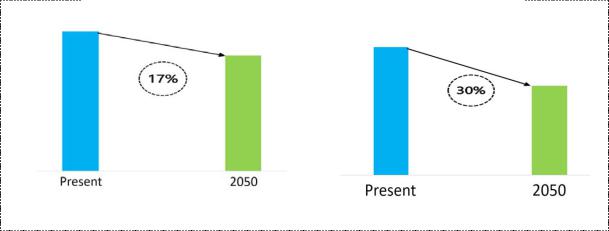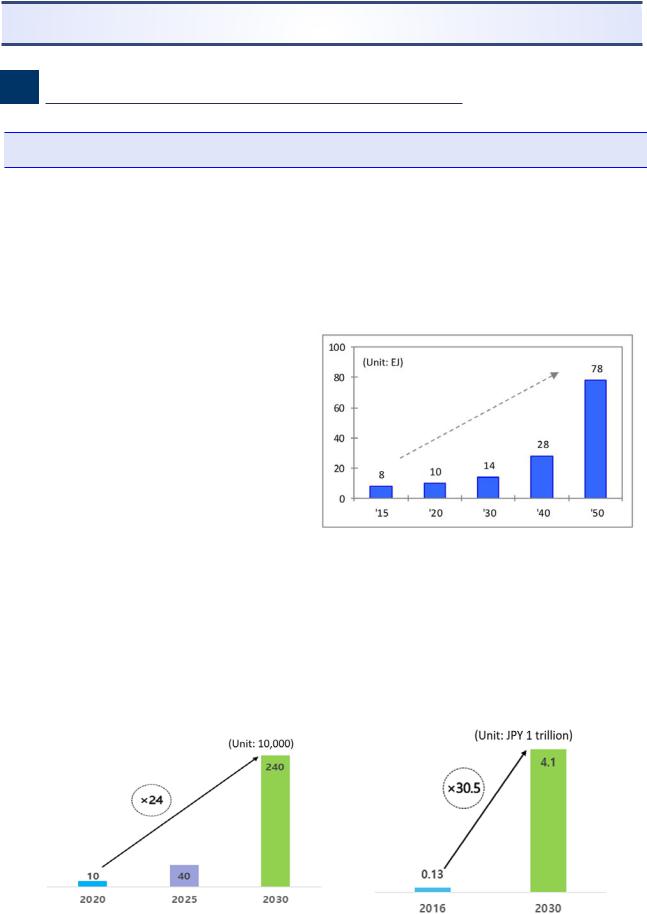
01 POWER ISLAND / 02 H2+NH3 / KOR-Hydrogen-Economy-Roadmap-of-Korea_REV-Jan19
.pdf
Hydrogen Economy Roadmap
of Korea
January 2019
Government of Korea
- 2 -

Contents
. Implications and Significance of the Hydrogen Economy ··· 1
. Trends in the Progress of the Hydrogen Economy ············· 5
. National Vision for the Hydrogen Economy ····················· 17
. Promotion Plan for the Hydrogen Economy ····················· 19
1) |
Establishment of the World’s Best Hydrogen Utilization System · 20 |
2) |
Expansion of a Stable and Universal Hydrogen Supply System ·· 44 |
3) |
Creation of the Industrial Ecosystem of the Hydrogen Economy ·· 56 |
4) |
Ensuring hydrogen safety ···································································· 70 |
. Future of the Hydrogen Economy ···································· 73

I. Implications and Significance of the Hydrogen Economy
What is Hydrogen Economy?
Characteristics of Hydrogen (H2)
|
Hydrogen (H2, element with atomic number 1) is the most abundant element in the universe. |
|
|
|
The use of hydrogen requires advanced technologies, and |
its major characteristics |
are: |
|
easily generated from water resources, possible to store in |
large quantities for long |
periods |
of time (energy carrier), and eco-friendly (CO2-free), as the only by-product produced when hydrogen is used to generate heat or electricity, through a chemical reaction with oxygen (O2), is water (H2O).
Hydrogen Economy
An economic system in which hydrogen is an important energy source, and hydrogen-based energy conversion technologies, such as fuel cells, are developed and utilized to reduce the use of fossil fuels and CO2 emissions.
Fostering of future industries + eco-friendly energy
Carbon Economy vs. Hydrogen Economy
|
Carbon Economy |
Hydrogen Economy |
|
|
Reliant on carbon resources |
Focusing on decarbonized hydrogen |
|
Energy |
(oil, coal, and natural gas) |
||
|
|||
Paradigm |
Dependent on imports (99 percent) |
Contributes to energy independence |
|
|
through domestic production |
||
|
|
||
|
|
|
|
|
Centralized energy supply and demand |
Distributed energy supply and demand |
|
Energy |
that requires large investment |
possible with small investment |
|
|
|
||
Supply |
Many location-related restrictions and low |
Few location-related restrictions and high |
|
|
|||
|
public acceptability |
public acceptability |
|
|
|
|
|
Competition |
Competition to develop resources and |
Competition to lead technological |
|
development and establish economy of |
|||
secure energy resources |
|||
|
size |
||
|
|
||
Environment |
Emission of GHGs and air pollutants |
Eco-friendly with low GHG emissions |
|
* CO2, NOx, SOx, etc. |
*By-product = H2O |
||
|
|||
|
|
|
- 1 -

Large effects of the hydrogen industry on upstream and downstream industries
□(Front Industries) Various new industries, ranging from transportation to energy, can be created.
(Transportation) A new industrial ecosystem can be created through the use of hydrogen throughout the entire transportation sector, from
passenger cars to commercial vehicles, trucks, forklifts, trains, ships, and airplanes.
* Global automobile market (2017): USD 2 trillion → Even if only 10 percent of vehicles in the global automobile market were converted to hydrogen, the resulting market would be about 1.5 times (USD 125.1 billion) the size of the semiconductor market and about half (USD 419 billion) the size of the display market.
(Energy) Fuel cells, which are eco-friendly and feature high energy generation efficiency, have emerged as an optimal alternative for distributed energy generation.
* Contribution of fuel cells to power generation worldwide: 215MW in 2013 → 299MW in 2015 → 670MW in 2017 (average annual increase of 225 percent)
< Comparison of Coal/Gas Power Generation and Fuel Cells>
|
Classification |
Coal |
Gas (Combined) |
Fuel Cell |
||
|
|
Capacity |
800 to 1,000MW |
400MW or more |
1KW to100MW |
|
Electrical Efficiency |
38 to 45 |
55 to 60 |
36 to 60 |
|||
|
|
(%) |
(90 including heat) |
|||
|
|
|
|
|||
|
|
|
|
|
|
|
Emiss |
SOx (ppm) |
50 |
- |
|
||
NOx (ppm) |
50 |
25 |
None |
|||
ions |
|
|||||
|
Fine Dust (Mg/Sm3) |
10 |
10 |
|
||
|
|
|
||||
|
Construction |
Years/many |
restrictions |
Months/urban |
||
Period/Location |
||||||
|
|
|
||||
|
|
|
|
|
|
|
- 2 -

□ (Downstream industries) High levels of value added can be generated in the fields of chemical and mechanical design (hydrogen production, transportation, and storage) materials and parts.
As most parts and materials used to produce hydrogen vehicles(FCEV) and fuel cells are produced by smalland medium-sized businesses (SMBs), the expansion of downstream industries will lead to increased investment in and job creation for related downstream companies.
*Number of parts by vehicle type (approximately): 30,000 for internal combustion
vehicles, 24,000 for hydrogen vehicles(FCEV), and 19,000 for electric vehicles
*Number of parts used in fuel cells (approximately): 10,000 for fuel cells used for power generation and 4,000 for fuel cells used in homes/buildings
Through the process of establishing various types of hydrogen infrastructure, such as eco-friendly hydrogen production facilities, large-scale storage and transportation facilities, and hydrogen fueling stations, continuous facility investment and employment expansion can be induced.
*As the development of more advanced hydrogen production, transportation, and storage
methods (water electrolysis, ultra-high-pressure, liquefaction, and liquid phase) progresses, new markets will be formed through the expansion of R&D and investment.
Contribution to energy independence through the generation of eco-friendly energy
□(Eco-friendly energy) Promotes a safe and clean society by reducing
GHG and fine dust emissions.
*Korea’s GHG reduction target: 37 percent below BAU levels by 2030
Social measures help to reduce fine dust* by using eco-friendly hydrogen in various industries such as transportation and power generation.
*Limitations on automobile use in the Seoul Metropolitan Area, restrictions on the operation of coal-fired powerplants, etc.
-3 -

< Prospects for Green Effect (McKinsey, 2018)>
GHG emission (BAU) |
Fine dust reduction |
The use of hydrogen makes it possible to overcome the disadvantages of renewable energy sources, such as solar and wind power, and allows for the formation of complementary relationships that enhance the utilization of hydrogen.
*Conversion of renewable energy into hydrogen to store and transport (P2G: Power to Gas)
□(Energy self-sufficiency) The domestic production of hydrogen through various means, such as hydrogen extraction and water electrolysis, can reduce dependency on foreign energy and thus promote energy independence.
The domestic production of hydrogen, through various methods, can
reduce import dependence and replace fossil fuels with hydrogen.
* Currently, more than 97 percent of Korea’s fossil fuels, which are the country’s major source of energy, is secured through imports.
- Korea’s energy independence in 2016: 18 percent (ranked 33rd among the 35 OECD countries)
In addition to domestic production, hydrogen can also be produced overseas and imported, creating an import diversification effect.
- 4 -

. Trends in the Progress of the Hydrogen Economy
1 Outlook of the Global Hydrogen Economy
USD 2.5 trillion in value added generated and 30 million jobs created by 2050
□The global hydrogen fuel cell market has shown rapid annual growth, with
the hydrogen industry expected to |
generate USD 2.5 trillion in value |
added and create 30 million jobs by 2050 (McKinsey Report). |
|
Sharply increasing from 8EJ in |
< Global Demand for Hydrogen Energy > |
2015 to 78EJ in 2050 |
|
- Expected to account for 18 percent of
energy demand (Hydrogen Council, 2018)
1EJ: 1018 joules = 170MMbbl (oil) = 278TWh (electricity)
The transportation sector will drive the increase in demand (including the rapid increase in the demand for fuel cells).
<Outlook of Hydrogen Vehicles(FCEV) Market (IEA)> <Outlook of the Fuel Cell Market (Fuji Economy)>
- 5 -

- (Hydrogen vehicles(FCEV)) About 7,800 hydrogen vehicles(FCEV)* have been distributed globally as of 2017 with high competition** among leading countries.
* Distribution by country as of 2017: 3,562 in the United States, 2,591 in Japan, 725 in the European Union, and 170 in Korea
**Distribution target by country (units of 10,000, 2020→2030): 15 → 180 in Germany, 4
→80 in Japan, and 0.5 → 100 in China
-(Fuel Cells) Asian countries will lead the growth of fuel cell market and technological competition will intensify.
* Asia accounted for 80 percent of fuel cell distribution globally as of 2017.
□ As the use of hydrogen for transportation and power generation increases, the resulting reduction in CO2 will account for 20 percent(60 billion tons annually) of the total required reduction by 2050.
2 Trends in Major Countries
Fierce Competition in the global market, but hydrogen economy remains in initial stage
(Japan) H2 Basic strategies to 2050(December 2017)
-Has been fostering the hydrogen economy with aim of achieving energy independence.
-Targets by 2030: 800,000 Hydrogen vehicles(FCEV), 1,200 hydrogen buses, 900 fueling stations, 5.3 million fuel cells for household use,
and unit price of power generation of JPY 17/kWh
-Focus on the development of hydrogen supply chain, including liquid hydrogen, P2G, overseas production, and low-cost hydrogen, based on the expansion of Hydrogen vehicles(FCEV) and fuel cells for household use (Ene-Farm).
-6 -
